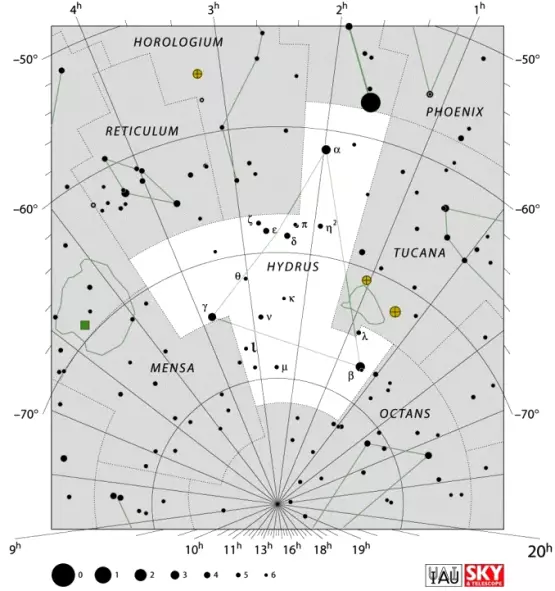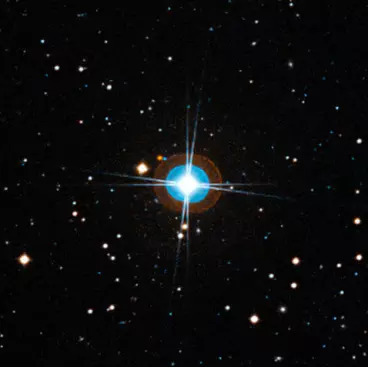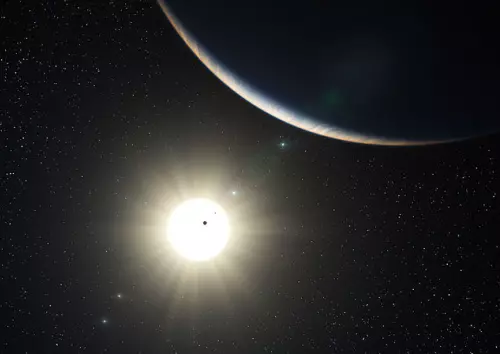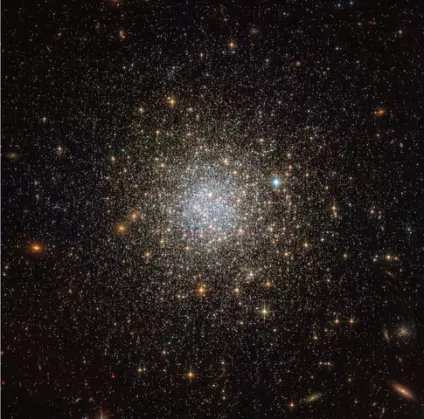Hydrus constellation lies in the southern hemisphere. Its name means “the male water snake” in Latin.
Hydrus is also known as “the lesser water snake,” the counterpart to the larger Hydra constellation, from which it is separated by the constellations Eridanus and Orion, and by the Milky Way. Hydrus lies between the two Magellanic Clouds, between Eridanus and the south celestial pole.
Hydrus was one of the constellations that first appeared on a celestial globe by the Dutch astronomer Petrus Plancius in 1597, and was subsequently included in Johann Bayer’s star atlas Uranometria in 1603. The constellation was created by Plancius from the observations of Dutch sailors Frederick de Houtman and Pieter Dirkszoon Keyser in the late 16th century.
Facts, location and map
Hydrus is the 61st constellation in size, occupying an area of 243 square degrees. It is located in the first quadrant of the southern hemisphere (SQ1) and can be seen at latitudes between +8° and -90°. The neighboring constellations are Dorado, Eridanus, Horologium, Mensa, Octans, Phoenix, Reticulum and Tucana.
The constellation name Hydrus is pronounced /ˈhaɪdrəs/. In English, the constellation is known as the Male Water Snake. The genitive form of Hydrus, used in star names, is Hydri (pronunciation: /ˈhaɪdraɪ/). The three-letter abbreviation, adopted by the International Astronomical Union (IAU) in 1922, is Hyi.
Hydrus belongs to the Johann Bayer family of constellations, along with Apus, Chamaeleon, Dorado, Grus, Indus, Musca, Pavo, Phoenix, Tucana and Volans.
Hydrus contains four stars with known planets and has no Messier objects. The brightest star in the constellation is Beta Hydri, with an apparent magnitude of 2.80. It is also the nearest star to Earth located in Hydrus constellation, only 24.38 light years away. The constellation does not contain any named stars. There are no meteor showers associated with the constellation.

Hydrus constellation map by IAU and Sky&Telescope magazine
Story
Hydrus is not associated with any myths. It is a southern constellation, one that wasn’t visible to the ancient Greeks or Romans. The constellation was mapped by Dutch navigators and it represents the sea snakes they would have seen on their voyages.
The French astronomer Nicolas Louis de Lacaille gave the constellation the name l’Hydre Mâle to emphasize the difference in gender between Hydrus and Hydra on his planisphere of the southern skies, published in 1756. Lacaille also transferred several stars to the constellations Tucana, Octans, Horologium, and Reticulum. In Bayer’s Uranometria (1603) Hydrus’ tail had extended to the star Lambda Octantis, which used to belong to Hydrus and is now part of the constellation Octans.
Hydrus stars
β Hydri (Beta Hydri)
Beta Hydri is the brightest star in the constellation. It has an apparent magnitude of 2.80 and is 24.33 light years distant from the Sun. The star is a yellow subgiant, with the stellar classification of G2 IV. It has 108 percent of the Sun’s mass and about 181 percent of the solar radius. It is 3.494 times more luminous than the Sun.
Beta Hydri is one of the oldest star in the Sun’s neighbourhood, as well as the nearest subgiant star to the solar system. Around the year 150 BC, it was only two degres from the southern celestial pole, and is now the nearest bright star to the South Pole.
In 2002, scientists inferred the possible presence of a substellar companion, thought to be a Jupiter-analogue, but the planet has not yet been confirmed in the star’s orbit.
α Hydri (Alpha Hydri)
Alpha Hydri, also known as the Head of Hydrus, is the second brightest star in the constellation. It has the stellar classification of F0 IV, which makes it a yellow-white subgiant star. It has an apparent magnitude of 2.90 and is 71.8 light years distant. The star lies to the south-west of Achernar, the ninth brightest star in the sky, located in the constellation Eridanus.
Alpha Hydri is 80 percent larger than the Sun and twice as massive. It is 32 times more luminous than the Sun. The star is believed to be about 810 million years old.
γ Hydri (Gamma Hydri)
Gamma Hydri is a luminous red giant belonging to the spectral class M2III. It has an apparent magnitude of 3.24 and is the third brightest star in Hydrus. It lies at the southeastern apex of the triangle asterism that dominates the constellation. It is approximately 214 light years distant from Earth. Gamma Hydri is 655 times more luminous than the Sun and has about 60 times the solar radius. The Chinese know the star as Foo Pih.
δ Hydri (Delta Hydri)
Delta Hydri is a white dwarf of the spectral type A3V. It has an apparent magnitude of 4.08. It is approximately 140 light years distant.
ε Hydri (Epsilon Hydri)
Epsilon Hydri is a blue-white giant with the stellar classification of B9III. It has an apparent magnitude of 4.06.
η2 Hydri (Eta-2 Hydri)
Eta-2 Hydri is a yellow giant of the spectral type G8.5III. It has an apparent magnitude of 4.68 and is approximately 219 light years distant from the solar system.
An extrasolar planet, Eta-2 Hydri b, was discovered orbiting the star in 2005. The planet has an orbital period of 711 days.
ν Hydri (Nu Hydri)
Nu Hydri is an orange giant star with the stellar classification K3III. It has a visual magnitude of 4.75 and is approximately 339 light years distant from Earth.
ζ Hydri (Zeta Hydri)
Zeta Hydri belongs to the spectral class A2IV-V, which means that it is a white star halfway between the subgiant and dwarf stage of evolution. It has an apparent magnitude of 4.83 and is approximately 284 light years distant from the solar system.
GJ 3021 (2 G. Hydri)
GJ 3021 is a double star in Hydrus, located approximately 57 light years away. It has an apparent magnitude of 6.59.
The primary component in the system, GJ 3021 A, is a solar analogue. It is a yellow dwarf with the stellar classification of G6 V. An extrasolar planet, GJ 3021 b, was confirmed to be orbiting the star in 2000. It is a Jovian planet with a mass at least 3.37 times that of Jupiter. The planet has an orbital period of 133.71 days.
The secondary component in the system, GJ 3021 B, is a class M4 red dwarf.
HD 10180
HD 10180 is another Sun-like star in Hydrus. It has the stellar classification of G1V, which makes it another yellow dwarf. It has an apparent magnitude of 7.33 and is approximately 127 light years distant from the solar system.

This image shows a close-up of the sky around the star HD 10180. The picture was created from photographs taken through red and blue filters and forming part of the Digitized Sky Survey 2. The field of view is approximately eleven arcminutes across. The blue and orange halos around the star, and the eight spikes of light, are artifacts of the imaging process and are not real. The remarkable planetary system around this star is far too faint and close in to be visible in this image. Image: ESO and Digitized Sky Survey 2. Acknowledgment: Davide De Martin
It has a mass about 6 percent greater than the Sun’s, and 120 percent of the Sun’s radius. The star is 149 percent more luminous than the Sun. Its estimated period of rotation is 24 days, and the estimated age of the star is about 7.3 billion years.
HD 10180 has a large planetary system, with at least seven (and possibly as many as nine) planets observed orbiting the star. It is the largest exoplanetary system known.

This artist’s impression shows the remarkable planetary system around the Sun-like star HD 10180. Observations with the HARPS spectrograph, attached to ESO’s 3.6-metre telescope at La Silla, Chile, have revealed the definite presence of five planets and evidence for two more in orbit around this star. This system is similar to the Solar System in terms of number of planets and the presence of a regular pattern in the sizes of the orbits. If confirmed the closest planet detected would be the lightest yet known outside the Solar System, with a mass that could be only about 1.4 times that of the Earth. Image: ESO/L. Calçada
Deep sky objects in Hydrus
IC 1717
IC 1717 was a deep sky object discovered by the Danish astronomer John Louis Emil Dreyer. Dreyer described it as an excessively small and faint, much extended object located near the yellow giant star Eta-2 Hydri. The coordinates he gave for the object were 01h 32m 30s (right ascension), 67°32’12” (declination), but whatever it was that Dreyer saw at those coordinates is no longer there. The object was probably not a supernova because it would have destroyed the planet in the Eta-2 Hydri system, so a popular theory is that the location was the site of a planet that was destroyed and that Dreyer saw the trail of the planet’s final orbit.
NGC 1511
NGC 1511 is a spiral galaxy in Hydrus. It has an apparent magnitude of 11.0. The galaxy was discovered by the British astronomer John Herschel on November 2, 1834.
NGC 1466
NGC 1466 is a globular cluster in Hydrus, also discovered by John Herschel in 1834. It has an apparent magnitude of 11.4 and is approximately 14,000 light years distant. The cluster is notable for the large number of RR Lyrae type variable stars, the brightest of which are magnitude 19.

This image from NASA’s Hubble Space Telescope reveals an ancient, glimmering ball of stars called NGC 1466. It is a globular cluster — a gathering of stars all held together by gravity — that is slowly moving through space on the outskirts of the Large Magellanic Cloud, one of our closest galactic neighbors. Blue straggler stars are blue, bright stars, with a higher mass than the average for a cluster, and they are expected to sink towards the center of a star cluster over time. Those closest to the cluster core are the first to migrate inwards, with more distant blue stragglers progressively moving inwards over time. Image: ESA and NASA
NGC 1473
NGC 1473 is an irregular galaxy in Hydrus. It has an apparent magnitude of 13.0. NGC 1473 was also discovered by John Herschel in November 1834.